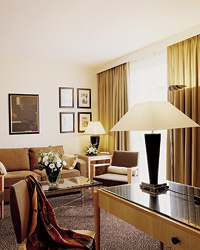 Starwood Hotels Starwood Hotels, Paris
Where to go, stay and eat in three European cities, while staying environmentally conscious.
Starwood Hotels Starwood Hotels, Paris
Where to go, stay and eat in three European cities, while staying environmentally conscious.
See our Eco-Friendly Guide to Paris, London and Stockholm slideshow.
With some of the most progressive capitals in the world, Europe makes eco-travel easy—provided you know where to look. For this new series, T+L partnered with Greenopia, the leading publisher of eco-guides to U.S. cities (greenopia.com), applying Greenopia’s environmental criteria to hotels, restaurants, stores, and sites in Paris, London, and Stockholm.
A 1990s-era Sir Terence Conran-designed hideaway at the edge of baroque Karlsplatz, Das Triest *** (doubles from $212) is emblematic of the city’s no-frills, economic approach to environmentalism. A keycard system turns off electricity and climate control when guests are out (non-air-conditioned rooms are also available), and candles are recycled to reduce waste. The hotel hardly feels like an ashram, however: rooms are warmly modern, with big blocks of wood paneling and quirky touches like now-retro Philippe Starck lamps.
Gabarage Upcycling Design, **** located on one of Vienna’s chicest streets, repurposes household and office items into furniture, including lamps made of used celluloid and a funky chaise longue created from old three-ring binders.
At Naschmarkt ** open market, stick to the northern end for farmer produce and fancy offerings, including Gegenbauer, with casks of homemade oils and vinegars, and Alles Seife’s handmade soap.
Tucked in a courtyard behind busy Stephansplatz, Hollmann’s Salon **** (dinner for two $100) serves exquisite portions of updated Viennese specials, including regional sheep and goat cheeses at long communal tables. Wrenkh *** (lunch for two $40), a wood-paneled place with a busy sidewalk annex, serves light, creative foods sourced from the Naschmarkt, like local venison and a smoked tofu steak atop a bed of polenta.
Grinzing is where the city’s vineyards start. Yellow Hapsburg-era houses with gothic signage and the inevitable strolling violinists provide a slightly kitschy 19th-century backdrop, but an influx of young vintners like Stefan Hajszan are transforming viniculture with 100 percent organic methods. Hajszan’s eponymous Heurige, a renovated grape-pressing house, has become one of the city’s hippest destinations. Downtown, the Contemporary Art Tower (open Sundays, May through November), a World War II anti-aircraft tower with concrete walls thicker than most sidewalks, has been converted to a showroom for projects by James Turrell and Jenny Holzer, among others. Minimal fluorescent lighting and nonexistent heating and cooling systems keep gallery spaces eco-friendly.
* Meets at least 25% of Greenopia’s criteria
** Meets at least 50% of Greenopia’s criteria
*** Meets at least 75% of Greenopia’s criteria
**** Meets at least 90% of Greenopia’s criteria